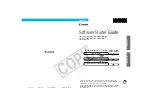
12
FN8085.3
July 29, 2005
FREQUENCY OUT CONTROL BITS (FO <3:0>)
These bits enable/disable the frequency output function and
select the output frequency at the IRQ/F
OUT
pin. See
Table 4 for frequency selection. When the frequency mode is
enabled, it will override the alarm mode at the IRQ/F
OUT
pin.
FREQUENCY OUTPUT AND INTERRUPT BIT (FOBATB)
This bit enables/disables the F
OUT
/IRQ pin during battery
backup mode (i.e. V
BAT
power source active). When the
FOBATB is set to “1” the F
OUT
/IRQ pin is disabled during
battery backup mode. This means that both the frequency
output and alarm output functions are disabled. When the
FOBATB is cleared to “0”, the F
OUT
/IRQ pin is enabled
during battery backup mode.
LOW POWER MODE BIT (LPMODE)
This bit enables/disables low power mode. With
LPMODE = “0”, the device will be in normal mode and the
V
BAT
supply will be used when V
DD
< V
BAT
- V
BATHYS
and
V
DD
< V
TRIP
. With LPMODE = “1”, the device will be in low
power mode and the V
BAT
supply will be used when
V
DD
< V
BAT
- V
BATHYS
. There is a supply current saving of
about 600nA when using LPMODE = “1” with V
DD
= 5V.
(See Typical Performance Curves: I
DD
vs V
CC
with
LPMODE ON & OFF.)
ALARM ENABLE BIT (ALME)
This bit enables/disables the alarm function. When the ALME
bit is set to “1”, the alarm function is enabled. When the ALME
is cleared to “0”, the alarm function is disabled. The alarm
function can operate in either a single event alarm or a periodic
interrupt alarm (see IM bit).
NOTE: When the frequency output mode is enabled, the alarm function
is disabled.
INTERRUPT/ALARM MODE BIT (IM)
This bit enables/disables the interrupt mode of the alarm
function. When the IM bit is set to “1”, the alarm will operate
in the interrupt mode, where an active low pulse width of
250ms will appear at the IRQ/F
OUT
pin when the RTC is
triggered by the alarm as defined by the alarm registers (0Ch
to 11h). When the IM bit is cleared to “0”, the alarm will
operate in standard mode, where the IRQ/F
OUT
pin will be
tied low until the ALM status bit is cleared to “0”.
Analog Trimming Register
ANALOG TRIMMING REGISTER (ATR<5:0>)
Six analog trimming bits, ATR0 to ATR5, are provided in
order to adjust the on-chip load capacitance value for
frequency compensation of the RTC. Each bit has a different
weight for capacitance adjustment. For example, using a
Citizen CFS-206 crystal with different ATR bit combinations
provides an estimated ppm adjustment range from -34 to
+80ppm to the nominal frequency compensation. The
combination of analog and digital trimming can give up to -94
to +140ppm of total adjustment.
The effective on-chip series load capacitance, C
LOAD
,
ranges from 4.5pF to 20.25pF with a mid-scale value of
12.5pF (default). C
LOAD
is changed via two digitally
controlled capacitors, C
X1
and C
X2
, connected from the X1
TABLE 4. FREQUENCY SELECTION OF F
OUT
PIN
FREQUENCY,
F
OUT
UNITS
FO3
FO2
FO1
FO0
0
Hz
0
0
0
0
32768
Hz
0
0
0
1
4096
Hz
0
0
1
0
1024
Hz
0
0
1
1
64
Hz
0
1
0
0
32
Hz
0
1
0
1
16
Hz
0
1
1
0
8
Hz
0
1
1
1
4
Hz
1
0
0
0
2
Hz
1
0
0
1
1
Hz
1
0
1
0
1/2
Hz
1
0
1
1
1/4
Hz
1
1
0
0
1/8
Hz
1
1
0
1
1/16
Hz
1
1
1
0
1/32
Hz
1
1
1
1
IM BIT
INTERRUPT/ALARM FREQUENCY
0
Single Time Event Set By Alarm
1
Repetitive/Recurring Time Event Set By Alarm
FIGURE 11. DIAGRAM OF ATR
C
X1
X1
X2
Crystal
Oscillator
C
X2
ISL1208
















































